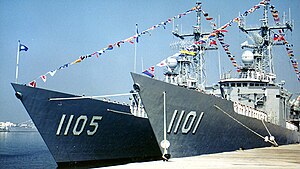Cheng Kung class frigate

ROCS Cheng Kung (1101) and ROCS Chi Kuang (1105)
|
|
| Class overview | |
|---|---|
| Name: | Cheng Kung class |
| Builders: | China Shipbuilding Corporation |
| Operators: |
|
| In commission: | 1993–Present |
| Completed: | 8 |
| Active: | 8 |
| General characteristics | |
| Type: | Frigate |
| Displacement: | 4,103 long tons (4,169 t) full load |
| Length: | 453 ft (138 m) |
| Beam: | 46.95 ft (14.31 m) |
| Propulsion: | 2 × General Electric LM2500-30 gas turbines, 41,000 shp (31 MW); 2 × Auxiliary Propulsion Units, 350 hp (.25 MW) |
| Speed: | over 29 knots (54 km/h) |
| Complement: | 235 |
| Sensors and processing systems: |
|
| Electronic warfare & decoys: |
|
| Armament: |
|
| Aircraft carried: | 2 × S-70C(M)-1/2 |
The Cheng Kung-class frigates are guided-missile frigates (PFG) currently in service of the Republic of China (Taiwan) Navy (ROCN). They are based upon the U.S. Oliver Hazard Perry class and built by China Shipbuilding Corporation in Kaohsiung, Taiwan under license throughout the 1990s as parts of the "Kuang Hua One" patrol frigate, guided project. These frigates served as the mainstay of the ROCN's theater air defense prior to the ROCN's acquisition of Keelung (Kidd)-class destroyers in 2005.
In order to control the new weapon systems on the frigates, which Mk 92 could not integrate at the time, a second CDS, H930 MCS was installed in order to control the 8 HF-2 (or four HF-2 and four HF-3 on certain ships) and the two Bofors 40mm/L70 guns. However, the Mk 92's Harpoon mode was deleted due to the US government refusal to sell the Harpoon missile system to Taiwan at the time. Also deleted were some of Mk 92's ASW modes, along with the refusal to sell SQR-19 Towed Array sonar system.
Originally only two lead ships were going to be built to this standard, the rest of the six ships in the class were going to be built under ACS (Advance Combat System) project with a lighter AEGIS (that later became SPY-1F), 48-64 cell Mark 41 Vertical Launch System and other systems, and a 15 metres (49 ft) plug-in section. Delay in the design and budget changed the project to four ships in PFG-1101 configuration and the last four ships in ACS configuration, then more delays changed to 6+2, then 7+1. By the mid 1990s, the ROCN decided the ACS project was too risky, too long and too over budget, finally canceling it after the seventh ship was built to the PFG-1101 standard. However, enough of the long lead items were already purchased so that in late 2000, the ROCN decided to go ahead with the eighth ship's construction with PFG-1101 configuration—minus the two Bofors 40mm/L70 guns, after getting necessary funding.
...
Wikipedia
